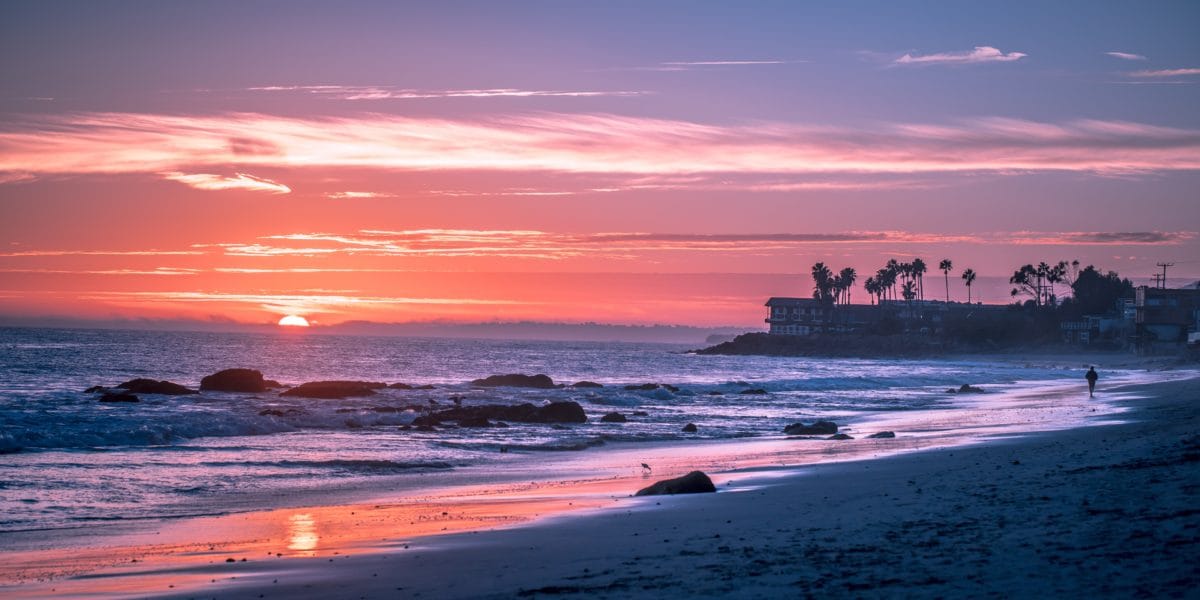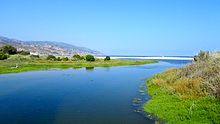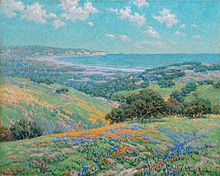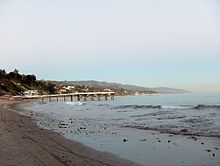
Malibu, California
| |
|---|---|
| City of Malibu | |

Aerial view of Downtown Malibu and surrounding neighborhoods
| |
| Nickname(s): | |

Location of Malibu in Los Angeles County, California
| |
Location in the Los Angeles Metropolitan Area
| |
| Coordinates: 34.03°N 118.75°WCoordinates: 34.03°N 118.75°W | |
| Country | |
| State | |
| County | |
| Incorporated (city) | March 28, 1991[4] |
| Named for | Chumash: Humaliwo, "The Surf Sounds Loudly"[5] |
| Government | |
| • Mayor | Karen Farrer |
| Area | |
| • Total | 19.83 sq mi (51.35 km2) |
| • Land | 19.79 sq mi (51.27 km2) |
| • Water | 0.03 sq mi (0.09 km2) 0.22% |
| Elevation | 105 ft (32 m) |
| Population | |
| • Total | 12,645 |
| • Estimate
(2018)[9]
| 12,777 |
| • Density | 650.65/sq mi (251.22/km2) |
| Time zone | UTC−8 (Pacific) |
| • Summer (DST) | UTC−7 (PDT) |
| ZIP Codes |
90263–90265[10]
|
| Area code(s) | 310/424 |
| FIPS code | 06-45246 |
| GNIS feature IDs | 1668257, 2410913 |
| Website | www |
Malibu (/ˈmælɪbuː/) (Spanish: Malibú) is a beach city in western Los Angeles County, California, situated about 30 miles (48 km) west of Downtown Los Angeles. It is known for its Mediterranean climate and its 21-mile (34 km) strip of the Malibu coast, incorporated in 1991 into the City of Malibu. The area is known for being the home of Hollywood movie stars, people in the entertainment industry, and other affluent residents. Most Malibu residents live within a few hundred yards of Pacific Coast Highway (State Route 1), which traverses the city, with some residents living up to a mile away from the beach up narrow canyons. As of the 2010 census, the city population was 12,645.
Nicknamed "the 'Bu" by surfers and locals,[1][2][3] beaches along the Malibu coast include Surfrider Beach, Zuma Beach, Malibu Beach, Topanga Beach, Point Dume Beach, County Line, and Dan Blocker Beach. State parks and beaches on the Malibu coast include Malibu Creek State Park, Leo Carrillo State Beach and Park,[11] Point Mugu State Park,[12] and Robert H. Meyer Memorial State Beach,[13] with individual beaches: El Pescador, La Piedra and El Matador. The many parks within the Santa Monica Mountains National Recreation Area lie along the ridges above the city along with local parks that include Malibu Bluffs Park[14] (formerly Malibu Bluffs State Park), Trancas Canyon Park, Las Flores Creek Park, and Legacy Park.[15]
Signs around the city proclaim "21 miles of scenic beauty", referring to the incorporated city limits. The city updated the signs in 2017 from the historical 27-mile (43 km) length of the Malibu coast spanning from Tuna Canyon on the southeast to Point Mugu in Ventura County on the northwest.[16] For many residents of the unincorporated canyon areas, Malibu has the closest commercial centers and they are included in the Malibu ZIP Codes. The city is bounded by Topanga on the east, the Santa Monica Mountains (Agoura Hills, Calabasas, and Woodland Hills) to the north, the Pacific Ocean to the south, and Solromar in Ventura County to the west.
Etymology[edit]
Malibu is named for the Ventureño Chumash settlement of Humaliwo, which translates to "The Surf Sounds Loudly." This pre-colonial village was situated next to Malibu Lagoon and is now part of the State Park.[17][18]
History[edit]
The area is within the Chumash territory which extended from the San Joaquin Valley to San Luis Obispo to Malibu, as well as several islands off the southern coast of California. The Native Americans named the settlement "Humaliwo"[19] or "the surf sounds loudly". The city's name derives from this, as the "Hu" syllable is not stressed.
The village of Humaliwo was located next to Malibu Lagoon and was an important regional center in prehistoric times. The village, which is identified as CA-LAN-264, was occupied from approximately 2,500 BCE. It was the second-largest Chumash coastal settlement by the Santa Monica Mountains, with just Muwu (Point Mugu) being more populated. Baptismal records list 118 individuals from Humaliwo. Humaliwo was considered an important political center, but there were also additional minor settlements in the Malibu area. One village, known as Ta’lopop, was located few miles up Malibu Canyon from Malibu Lagoon. Research have shown that Humaliwo (Malibu) had ties to other villages in pre-colonial times, including Hipuk (in Westlake Village), Lalimanux (by Conejo Grade) and Huwam (in Bell Canyon).[20][21]
Explorer Juan Rodríguez Cabrillo is believed to have moored at Malibu Lagoon, at the mouth of Malibu Creek, to obtain fresh water in 1542. The Spanish presence returned with the California mission system, and the area was part of Rancho Topanga Malibu Sequit—a 13,000-acre (53 km2) land grant—in 1802. That ranch passed intact to Frederick Hastings Rindge in 1891. He and his wife, Rhoda May Knight Rindge, were very staunch about protecting their land. After his death, Rhoda May guarded their property zealously by hiring guards to evict all trespassers and fighting a lengthy court battle to prevent the building of a Southern Pacific railroad line through the ranch. Interstate Commerce Commission regulations would not support a railroad condemning property in order to build tracks that paralleled an existing line, so Frederick H. Rindge decided to build his own railroad through his property first. He died, and May K. Rindge followed through with the plans, building the Hueneme, Malibu and Port Los Angeles Railway. The line started at Carbon Canyon, just inside the ranch's property eastern boundary, and ran 15 miles westward, past Pt. Dume.[22][23][24][25]
Few roads even entered the area before 1929, when the state won another court case and built what is now known as the Pacific Coast Highway. By then May Rindge was forced to subdivide her property and begin selling and leasing lots. The Rindge house, known as the Adamson House[26] (a National Register of Historic Places site and California Historical Landmark), is now part of Malibu Creek State Park and is situated between Malibu Lagoon State Beach[27] and Surfrider Beach, beside the Malibu Pier[28] that was used to provide transportation to/from the ranch, including construction materials for the Rindge railroad, and to tie up the family's yacht.[25][29]
In 1926, in an effort to avoid selling land to stave off insolvency, May K. Rindge created a small ceramic tile factory. At its height, Malibu Potteries employed over 100 workers, and produced decorative tiles which furnish many Los Angeles-area public buildings and Beverly Hills residences. The factory, located one-half-mile east of the pier, was ravaged by a fire in 1931.[30] Although the factory partially reopened in 1932, it could not recover from the effects of the Great Depression and a steep downturn in Southern California construction projects. A distinct hybrid of Moorish and Arts and crafts designs, Malibu tile is considered highly collectible. Fine examples of the tiles may be seen at the Adamson House and Serra Retreat, a fifty-room mansion that was started in the 1920s as the main Rindge home on a hill overlooking the lagoon. The unfinished building was sold to the Franciscan Order in 1942[31] and is operated as a retreat facility,[32] Serra Retreat. It burned in the 1970 fire and was rebuilt using many of the original tiles.
Most of the Big Rock Drive area was purchased in 1936 by William Randolph Hearst, who considered building an estate on the property. He sold the lower half of his holdings there in 1944 to Art Jones. Jones was one of the prominent early realtors in Malibu, starting with the initial leases of Rindge land in Malibu Colony. He was also the owner/part-owner of the Malibu Inn, Malibu Trading Post and the Big Rock Beach Cafe (which is now Moonshadows restaurant). Philiip McAnany owned 80 acres (32 ha) in the upper Big Rock area, which he had purchased in 1919, and had two cabins there, one of which burned in a brush fire that swept through the area in 1959, and the other in the 1993 Malibu fire. McAnany Way is named after him.[33][34][35][36]
Malibu Colony[edit]
Malibu Colony was one of the first areas with private homes after Malibu was opened to development in 1926. As one of Malibu's most famous districts,[37] it is located south of Malibu Road and the Pacific Coast Highway, west of Malibu Lagoon State Beach, and east of Malibu Bluffs Park (formerly a state park). May Rindge had protected the Malibu coast with only a few wealthy Hollywood stars having vacation homes there. Rindge opened up this small area for development in 1926. The long legal battle to protect her beloved Malibu coast had been costly and she eventually died penniless.[38] Long known as a popular private enclave for wealthy celebrities,[39] the Malibu Colony today is a gated community, with multimillion-dollar homes on small lots. The Colony has views of the Pacific Ocean, with coastline views stretching from Santa Monica to Rancho Palos Verdes to the south (known locally as the Queen's Necklace[40]) and the bluffs of Point Dume to the north.
High technology in Malibu[edit]
The first working model of a laser was demonstrated by Theodore Maiman in 1960 in Malibu at the Hughes Research Laboratory[41] (now known as HRL Laboratories LLC). In the 1990s HRL Laboratories developed the FastScat computer code,[42] for frequency domain algorithms and implementation, recognized as perhaps the most accurate code in the world for radar cross-section calculations.[citation needed] TRW built a laboratory in Solstice Canyon without any structural steel to test magnetic detectors for satellites and medical devices.[43]
Incorporation[edit]
In 1991 most of the old Malibu land grant was incorporated as a city to allow local control of the area (as cities under California law, they are not subject to the same level of county government oversight). Prior to achieving municipal status, the local residents had fought several county-proposed developments, including an offshore freeway,[44] a nuclear power plant,[45] and several plans to replace septic tanks with sewer lines to protect the ocean from seepage that pollutes the marine environment. The incorporation drive gained impetus in 1986, when the Los Angeles County Board of Supervisors approved plans for a regional sewer that would have been large enough to serve 400,000 people in the western Santa Monica Mountains. Residents were incensed that they would be assessed taxes and fees to pay for the sewer project, and feared that the Pacific Coast Highway would need to be widened into a freeway to accommodate growth that they did not want. The supervisors fought the incorporation drive and prevented the residents from voting, a decision that was overturned in the courts.
The city councils that were elected in the 1990s were unable to write a Local Coastal Plan (LCP) that preserved enough public access to satisfy the California Coastal Commission, as required by the California Coastal Act. The state Legislature eventually passed a Malibu-specific law that allowed the Coastal Commission to write an LCP for Malibu, thus neutering the city's ability to control many aspects of land use. Because of the failure to adequately address sewage disposal problems in the heart of the city, the local water board ordered Malibu in November 2009 to build a sewage plant for the Civic Center area. The city council has objected to that solution.[46]
Geography[edit]
Malibu is located at 34°1′50″N 118°46′43″W (34.030450, −118.778612).[47] Its City Hall building is located at 23825 Stuart Ranch Road (34°02′21″N 118°41′35″W). The eastern end of the city borders the Topanga CDP, which separates it from the city of Los Angeles.
According to the United States Census Bureau, the city has a total area of 19.8 square miles (51 km2), over 99% of it land.
Malibu's dry brush and steep clay slopes make it prone to fires, floods, and mudslides.
Carbon Beach, Surfrider Beach, Westward Beach, Escondido Beach, Paradise Cove, Point Dume, Pirates Cove, Zuma Beach, Trancas and Encinal Bluffs are places along the coast in Malibu. Point Dume forms the northern end of the Santa Monica Bay, and Point Dume Headlands Park affords a vista stretching to the Palos Verdes Peninsula and Santa Catalina Island. Directly below the park, on the western side of the point, is Pirates Cove. Because of its relative seclusion, Pirate's Cove was previously used as a nude beach, but since nudity is now illegal on all beaches in Los Angeles County, nude sunbathers are subject to fines and/or arrest.
Like all California beaches, Malibu beaches are technically public land below the mean high tide line. Many large public beaches (Zuma Beach, Surfrider Beach) are easily accessible, but such access is sometimes limited for some of the smaller and more remote beaches. Some Malibu beaches are private, such as Paradise Cove, which charges an entrance fee to keep the crowds at bay.[48]
Climate[edit]
This region experiences warm and dry summers, with no average monthly temperatures above 71.6 °F (22 °C). According to the Köppen Climate Classification system, Malibu has a warm-summer Mediterranean climate, abbreviated "Csb" on climate maps.[49] The city's climate is influenced by the Pacific Ocean, resulting in far more moderate temperatures than locations further inland experience. Snow in Malibu is extremely rare, but flurries with higher accumulations in the nearby mountains occurred on January 17, 2007.
[50]






Hints & tips

Disclaimer
The above comments are based on my
personal travel experiences to this particular location in summer months. Your
experience may vary due to weather and traffic.
My trips were not sponsored by any of
the authorities and my comments are not biased or representing any views of
governing bodies.
History and information extracted from
Wikipedia and photos were selected from Google images and all rights reserved
with original owners.
This is only for an informational
purpose. Not for commercial use.
Note.
Hope you will enjoy your visit.
Please make your comments, suggestions & travel questions. I am happy to
provide information on my earliest convenience & update the post
accordingly.
| hideClimate data for Malibu, California | |||||||||||||
|---|---|---|---|---|---|---|---|---|---|---|---|---|---|
| Month | Jan | Feb | Mar | Apr | May | Jun | Jul | Aug | Sep | Oct | Nov | Dec | Year |
| Record high °F (°C) | 85 (29) | 89 (32) | 90 (32) | 99 (37) | 88 (31) | 92 (33) | 91 (33) | 95 (35) | 104 (40) | 99 (37) | 100 (38) | 89 (32) | 104 (40) |
| Average high °F (°C) | 63.5 (17.5) | 62.7 (17.1) | 63.2 (17.3) | 63.7 (17.6) | 65.2 (18.4) | 67.3 (19.6) | 70.1 (21.2) | 71.3 (21.8) | 71.1 (21.7) | 70.2 (21.2) | 67.2 (19.6) | 63.6 (17.6) | 66.6 (19.2) |
| Average low °F (°C) | 50.8 (10.4) | 51.6 (10.9) | 53.2 (11.8) | 54.8 (12.7) | 56.9 (13.8) | 59.6 (15.3) | 62.8 (17.1) | 63.4 (17.4) | 59.8 (15.4) | 58.8 (14.9) | 55.2 (12.9) | 50.9 (10.5) | 56.5 (13.6) |
| Record low °F (°C) | 34 (1) | 35 (2) | 33 (1) | 39 (4) | 43 (6) | 45 (7) | 51 (11) | 52 (11) | 44 (7) | 42 (6) | 37 (3) | 34 (1) | 33 (1) |
| Average precipitation inches (mm) | 2.84 (72) | 3.44 (87) | 1.96 (50) | 0.66 (17) | 0.21 (5.3) | 0.04 (1.0) | 0.01 (0.25) | 0.04 (1.0) | 0.13 (3.3) | 0.5 (13) | 1.08 (27) | 1.88 (48) | 12.79 (324.85) |
Source: The Weather Channel | |||||||||||||










No comments:
Post a Comment